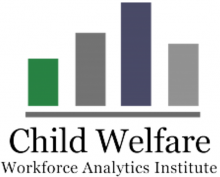Introduction to Workforce Analytics
The Quality Improvement Center for Workforce Development created the Child Welfare Workforce Analytics Institute (the Institute). The goals of the Institute are to:
- inspire and motivate child welfare leaders and human resources (HR) staff to work together to use data analytics to address child welfare workforce challenges,
- provide opportunities for initiating and strengthening connections between child welfare and HR leaders,
- build awareness, knowledge, and/or understanding around data analytics, and
- support agencies to initiate plans to use HR data to address child welfare workforce challenges.
This blog post provides an overview of workforce analytics as presented to Institute participants in spring 2020.
Workforce Analytics History
During the 1950s, pioneers of HR analytics begin advocating for “putting people on the balance sheet.” Throughout the 1980s and 1990s, researchers wrestled with workforce analytics and how to make sense of human resource metrics. Industrial-organizational psychology began looking at the utility of employee performance, but researchers continued to be puzzled and saddened by the “black box” of mystery correlations between high-performance work systems and organizational performance. Businesses still widely held the belief that human resources could not, and even should not, be measured. It wasn’t until the early 2000s that measuring workforce activities began to be more widely accepted. Although workforce analytics is not an altogether new concept, it wasn’t until relatively recently that organizations started to use these data in more meaningful ways. With advances in technology, organizations now have a lot more data to work with, and the goal is to try to better utilize those data.
For more information see:
Bassi, L. (2011). Raging debates in HR analytics. Brooklyn: McBassi & Company.
Caudron, S. (2004). Jac Fitz-enz, metrics maverick.
Key Terminology
|
Workforce Analytics: The process of systematically collecting and analyzing workforce data to drive human resource management decisions, with the goal of improving employee well-being, performance, and retention, in order to improve child welfare outcomes for children and families. |
There are a variety of labels for the concept of workforce analytics including HR Analytics, Human Capital Analytics, People Analytics, and Talent Analytics, just to name a few. Although these terms differ slightly, they are often used interchangeably. Additionally, you will not find consensus on the exact definition of these terms. For our purposes, we are offering this definition of Workforce Analytics: The process of systematically collecting and analyzing workforce data to drive human resource management decisions, with the goal of improving employee well-being, performance, and retention, in order to improve child welfare outcomes for children and families.
Reporting vs. Analytics
Reporting and analytics are two important functions in any organization, but they serve different purposes. The decision of which one to use should be driven by the type of question you are asking. In general, the following should be considered:
- Are you looking at what has happened or what should happen? Reporting typically provides information about the past, whereas analytics are characterized by being forward thinking.
- Reporting is process-based and descriptive, whereas the use of analytics serves to understand the root causes beneath the surface.
- Use reporting to highlight past workforce trends and analytics if you are looking to problem-solve around those trends.
- Reporting provides descriptive snapshots at a certain point in time, whereas analytics deliver insights that can inform decision making.
There are five levels of reporting and analytics, as can be seen in the graphic below from Hill & Houghton. Organizations should prioritize having a balanced reporting and analytics strategy that is driven by the types of questions being asked. For example, at the descriptive level you are able to answer the question, “what happened?” whereas at the diagnostic level you can answer the question, “why did it happen?” At the predictive level you would be able to answer the question, “what will happen next?” and at the prescriptive level you would be able to more fully explore “what action should be taken?”

For more information see:
The Benefits and Value-Add of Workforce Analytics
Although the concept of workforce analytics is gaining steam, it should be noted that using workforce analytics is far from being ‘business as usual’ across industries, let alone in the field of child welfare. Research suggests that when workforce analytics is used, it adds demonstrable value to organizations. To ensure that a workforce analytics initiative will add value to the agency, three primary checkpoints should be considered:
- Will be insightful—Will it tell your audience something they didn’t already know or couldn’t get from reporting alone?
- Will it be relevant—Is it about something that really matters in the context of your specific agency?
- Will be actionable—Could the agency feasibly act on this information? Will the insights gleaned realistically trigger a meaningful intervention?
There are many potential benefits to using workforce analytics, including the potential to be more efficient and use data to drive agency decision making, the opportunity to evaluate those decisions, and the chance to produce new insights. We encourage child welfare agencies to consider beginning conversations between their child welfare and HR departments about how they can partner to better leverage their data to explore the myriad of workforce issues in the field.
For more information see:
